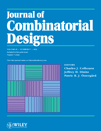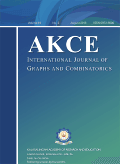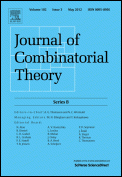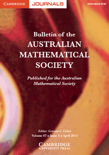
JOURNAL OF COMBINATORIAL DESIGNS
Scope & Guideline
Fostering Insights in Combinatorial Theory and Practice
Introduction
Aims and Scopes
- Combinatorial Designs and Block Designs:
The journal publishes research on various types of combinatorial designs, including balanced incomplete block designs (BIBDs), Steiner systems, and group divisible designs. These studies often explore existence, constructions, and properties of such designs. - Graph Theory and Combinatorics:
Papers frequently delve into graph-theoretical aspects of combinatorial designs, examining topics like chromatic numbers, graph decompositions, and properties of specific graph classes. - Coding Theory and Error-Correcting Codes:
Research articles often bridge combinatorial designs with coding theory, discussing topics such as maximum distance separable (MDS) codes, orthogonal arrays, and the construction of codes from combinatorial structures. - Algebraic Combinatorics:
The journal includes studies that apply algebraic techniques to combinatorial problems, such as using group theory to classify designs or analyze their symmetries. - Algorithmic and Computational Aspects:
Many publications focus on the algorithmic side of combinatorial designs, including complexity analysis, enumeration problems, and computational methods for constructing and analyzing designs.
Trending and Emerging
- Advanced Algebraic Techniques:
There is a growing trend towards employing advanced algebraic methods in the study of combinatorial designs, such as the use of group theory and algebraic structures to derive new results and insights. - Interdisciplinary Applications:
An increase in research that applies combinatorial designs to other fields, such as computer science, optimization, and telecommunications, indicates a trend towards interdisciplinary collaboration and application of combinatorial principles. - Complexity and Algorithmic Studies:
Recent works focus heavily on algorithmic aspects of combinatorial designs, exploring computational complexity, efficient algorithms for construction, and enumeration algorithms, reflecting an increased interest in practical applications of theoretical results. - Graph-Theoretic Connections:
A notable rise in studies that explore connections between combinatorial designs and graph theory, particularly concerning properties of specific graph classes and their applications in coding and design theory.
Declining or Waning
- Elementary Construction Techniques:
Papers that focus solely on elementary construction methods for combinatorial designs seem to be declining. The trend is shifting towards more sophisticated and algebraic methods, moving away from simpler approaches. - Historical Perspectives and Classical Results:
There has been a noticeable reduction in papers that review historical perspectives or revisit classical results in combinatorial designs. The focus is increasingly on novel contributions rather than historical recounting. - Basic Enumeration Problems:
While enumeration remains a relevant topic, basic enumeration problems are being replaced by more complex and nuanced studies that integrate combinatorial designs with other mathematical fields, indicating a shift towards interdisciplinary approaches.
Similar Journals

JOURNAL OF ALGEBRAIC COMBINATORICS
Advancing the frontier of algebra and combinatorics.JOURNAL OF ALGEBRAIC COMBINATORICS, published by SPRINGER, stands as a premier resource in the fields of algebra and combinatorics, playing a pivotal role in advancing research in these disciplines. With an esteemed impact factor reflective of its academic rigor, it holds a prestigious Q1 ranking in both Algebra and Number Theory, as well as in Discrete Mathematics and Combinatorics, according to 2023 assessments. Established in 1992, this journal features contributions from leading experts worldwide, offering insights into the latest developments and methodologies. Although not an open-access journal, it provides a wealth of valuable information and research findings focusing on combinatorial structures, theory, and applications that are essential for advancing academic inquiry. As a vital publication for researchers, professionals, and students alike, JOURNAL OF ALGEBRAIC COMBINATORICS continues to shape the conversation within the mathematical community and beyond, making it indispensable for those engaged in the dynamic landscape of mathematical sciences.

Transactions on Combinatorics
Exploring the Frontiers of Computational TheoryTransactions on Combinatorics is an esteemed academic journal dedicated to advancing the field of combinatorial mathematics. Published by UNIV ISFAHAN, VICE PRESIDENT RESEARCH & TECHNOLOGY, this journal has been an Open Access platform since 2012, ensuring that innovative research is freely available to scholars across the globe. With an ISSN of 2251-8657 and an E-ISSN of 2251-8665, it fosters a community for researchers to disseminate their findings within the realms of Computational Theory and Discrete Mathematics. The journal has been classified in the Q4 category for both its major fields in 2023 and holds notable Scopus rankings that reflect its growing influence in the academic community, despite currently being in the lower quartiles. The journal covers a diverse range of topics from theoretical frameworks to practical applications, making it a valuable resource for researchers, professionals, and students who are passionate about combinatorics. Addressed from DEPT PRINTING & PUBLISHING MAGAZINES, HEZAR-JARIB AVE, ISAFAHAN 81746-73441, IRAN, it stands as a beacon for collaborative research and knowledge sharing in this essential field.

AKCE International Journal of Graphs and Combinatorics
Unlocking the Secrets of Graphs and Combinatorial Structures.AKCE International Journal of Graphs and Combinatorics, published by TAYLOR & FRANCIS LTD, serves as a significant platform in the field of Discrete Mathematics and Combinatorics. With its commitment to open access since 2015, the journal ensures that cutting-edge research is readily available to a global audience, promoting the dissemination of knowledge and high-quality scholarship. Recognized for its impact in the discipline, the journal is currently ranked Q3 in its category for 2023 and holds a commendable Scopus ranking, falling within the 69th percentile. Researchers, professionals, and students alike will find invaluable insights and contributions in this journal, which spans a wide range of topics related to graph theory and combinatorial structures. Operating from its base in India, and converging from 2011 to 2024, the AKCE International Journal invites submissions that push the boundaries of mathematical exploration and foster innovative methodologies in a rapidly evolving field.

Journal of Integer Sequences
Innovative Insights: Connecting Researchers in Integer SequencesJournal of Integer Sequences, published by University of Waterloo, stands as a vital resource within the field of Discrete Mathematics and Combinatorics. This open-access journal, which has been in circulation since 1998, is dedicated to the study and dissemination of research concerning integer sequences, a fundamental aspect in various mathematical disciplines. With a current impact factor reflected by its Q3 ranking in the 2023 category of Discrete Mathematics and Combinatorics, the journal enhances its visibility through a dedicated approach to scholarly excellence and engagement with cutting-edge research. Positioned in Canada, the journal encourages contributions from researchers, professionals, and students alike, fostering a collaborative environment where innovative mathematical ideas can flourish. Explore the depths of integer sequences and their applications by accessing this journal for vital insights and advancements in the field.

JOURNAL OF COMBINATORIAL THEORY SERIES B
Championing Excellence in Discrete MathematicsJOURNAL OF COMBINATORIAL THEORY SERIES B, published by Academic Press Inc., Elsevier Science, is an esteemed journal within the discipline of combinatorial theory, discrete mathematics, and theoretical computer science. With a rich history since its inception in 1971 and ongoing publication through 2025, this journal has established itself as a pillar in its field, currently holding Q1 category rankings in multiple areas including Computational Theory and Mathematics, Discrete Mathematics and Combinatorics, and Theoretical Computer Science. The journal features cutting-edge research and developments, attracting contributions from both established professionals and emerging scholars. Despite the absence of an open access option, the journal's strong impact reflected in its Scopus ranks—such as being number 16 out of 92 in Discrete Mathematics and Combinatorics (83rd percentile)—signifies its influential role in advancing knowledge and innovation. Researchers seeking to share impactful findings and connect with a vibrant academic community will find the JOURNAL OF COMBINATORIAL THEORY SERIES B an essential resource.

Algebra And Discrete Mathematics
Innovative Insights in Algebra and Discrete MathematicsAlgebra And Discrete Mathematics, published by LUHANSK TARAS SHEVCHENKO NATIONAL UNIVERSITY, is a pivotal academic journal dedicated to exploring the realms of algebra and discrete mathematics. Since its inception in 2012, this journal has contributed significantly to the mathematical community, catering to researchers, professionals, and students interested in advancing their understanding of both classical and contemporary mathematical theories. With categories placed in Q4 in Algebra and Number Theory and Q3 in Discrete Mathematics and Combinatorics, and rankings that place it among various domains with percentiles reflecting its niche status, the journal offers a platform for innovative and high-quality research. While the journal is currently not open access, it maintains a robust academic presence, and its continuous publication until 2024 ensures a steady stream of scholarly discourse. Researchers and academics keen on disseminating their findings or keeping abreast of the latest developments in these mathematical fields will find valuable insights and diverse methodologies within its pages.

Prikladnaya Diskretnaya Matematika
Connecting Scholars with Cutting-Edge Computational Insights.Prikladnaya Diskretnaya Matematika, published by the PUBLISHING HOUSE SCIENTIFIC & TECHNICAL LITERATURE in the Russian Federation, serves as a vital resource for scholars and practitioners in the realms of applied mathematics, computational theory, and discrete mathematics. With an ISSN of 2071-0410 and an E-ISSN of 2311-2263, this journal has been actively contributing to the academic discourse since its inception in 2016, with expectations to continue until at least 2024. Although currently positioned in the Q4 category across several disciplines—including applied mathematics, computational theory, and signal processing—this journal offers a unique opportunity for researchers to contribute to an evolving field, despite facing competitive rankings in the Scopus database. The open access nature of the journal reflects a commitment to disseminating knowledge broadly, albeit details regarding access options remain unspecified. As a publication dedicated to fostering innovation and collaboration in theoretical and practical applications, Prikladnaya Diskretnaya Matematika plays an important role in advancing mathematical theories and practices, making it pertinent for those engaged in research and application within these critical domains.

BULLETIN OF THE AUSTRALIAN MATHEMATICAL SOCIETY
Empowering the Mathematical Community Through KnowledgeBULLETIN OF THE AUSTRALIAN MATHEMATICAL SOCIETY is an esteemed journal dedicated to advancing the field of mathematics, published by Cambridge University Press. Since its inception in 1969, this periodical has fostered scholarly communication and showcased pivotal research in various domains of mathematics, now projected to continue until 2024. With an impact factor that places it in the Q2 category of miscellaneous mathematics research, it holds a notable position among its peers, ranking 215th out of 399 in the Scopus database. Though it does not currently offer open access options, the journal remains a vital resource for researchers, professionals, and students seeking to deepen their understanding of mathematical advancements. The Bulletin serves as a crucial platform for disseminating original research, comprehensive reviews, and insightful perspectives that navigate the complexities of mathematics today, ensuring the community is well-informed and engaged.

CANADIAN JOURNAL OF MATHEMATICS-JOURNAL CANADIEN DE MATHEMATIQUES
Fostering collaboration and innovation in mathematics.Canadian Journal of Mathematics - Journal Canadien de Mathématiques is a prestigious peer-reviewed journal published by Cambridge University Press, which aims to advance the field of mathematics through the dissemination of high-quality research articles. With its ISSN 0008-414X and E-ISSN 1496-4279, the journal plays a pivotal role in fostering mathematical research and collaboration. It has been recognized for its impactful contributions, currently holding a category quartile ranking of Q2 in Mathematics (miscellaneous) for 2023 and sits in the 66th percentile among its peers according to Scopus rankings. As the journal continues its convergence from its inception in 1994 through to 2024, it remains a vital resource for researchers, professionals, and students seeking to stay at the forefront of mathematical developments. The journal does not operate under an open access model, allowing for a curated collection of articles that adhere to rigorous academic standards.

GRAPHS AND COMBINATORICS
Exploring the intricate world of graphs and combinatorics.GRAPHS AND COMBINATORICS, published by SPRINGER JAPAN KK, is a premier academic journal dedicated to advancing the field of discrete mathematics and combinatorial theory. ISSN 0911-0119 and E-ISSN 1435-5914 signify its scholarly accessibility, providing a platform for the dissemination of cutting-edge research from 1985 to the present. With a 2023 quartile ranking of Q2 in Discrete Mathematics and Combinatorics and Q3 in Theoretical Computer Science, the journal showcases influential studies that significantly contribute to these domains. Situated in Tokyo, Japan, it harnesses a global perspective on contemporary mathematical challenges. Although lacking open access options, GRAPHS AND COMBINATORICS remains a vital resource for researchers, professionals, and students seeking to deepen their understanding of mathematical graph theory and combinatorial structures. Engage with its significant findings and join the discourse that shapes future research and applications in these inspiring fields.